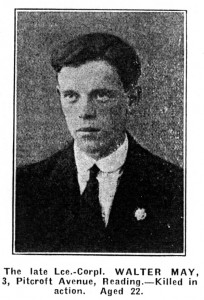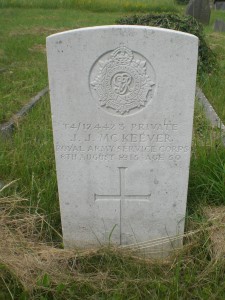Walter May
Lance Corporal 12760
6th Royal Berkshire Regiment
 |
Walter May was the eldest son of Mr Tom and Mrs Emma May of 3 Pitcroft Avenue, Reading. The 1911census indicates that he was a Clerk Seedsman, probably at Suttons, his father and a younger brother also workedfor the same firm. Walter May had two sisters. He joined up on the 5th September 1914 and went to France on 25th July 1915.
The 6th Battalion Royal Berkshire Regiment, with which Walter served, was part of the 18th Division and was amongst those few battalions which had some success on the first day of the battle of the Somme. They were situated on the far right of the British line near the French and achieved their objective, the taking of Montauban. The battalion was also involved in a fateful attack on Delville Wood on the 19th July when many men were lost in a badly planned operation. The Somme battle continued wearily with great loss of men on both sides through the summer and autumn of 1916. The 6th battalion was involved in the actions which finally resulted in the eventual successful capture of most of the Thiepval ridge from the Germans.
Thiepval had been a first day objective of the Somme offensive. The 18th Division was given the task of taking Thiepval and also the strong point known as the Schwaben Redoubt. “On the Somme” by Colin Fox et al., gives an account of the involvement of the 6th Battalion. The Division had three weeks battle training prior to the attack which was set for 26th September. The 6th Royal Berkshire Regiment was in the brigade reserve with the 8th Suffolks leading the attack with the 10th Essex Regiment. There were three days of preliminary bombardment with zero hour at 12.35pm on the 26th September. The initial attack on Thiepval was very successful with the Germans, according to the Official History, eager to surrender without a fight.
However, progress towards the Schwaben redoubt was much more difficult and the advanced came to a standstill at about 6.20pm. The 6th Berks now provided carrying parties with the task of bringing food, water and ammunition to the front line troops. The reserve was in trenches at Crucifix Corner and it was here at dusk that the Germans sent over a massive barrage. On the 28th September there was a renewed attack on the Schwaben Redoubt, the 6th Berks. were again in the reserve, this time in Authuille Wood. The attacking battalions sustained heavy casualties and the following morning the 6th Berks. were sent in to relieve the Suffolks. They were heavily shelled all day, and many of the men were suffering from a lack of sleep. Walter May would have experienced the spasmodic bombing attacks carried out by both sides and the heavy shelling , which in deteriorating weather, reduced the ground into a sea of mud. By the 5th October the Redoubt was back in British hands. On the 6th October the 6th Royal Berkshire were withdrawn from the line and moved into billets.
Walter May was one of the 14 men killed during this action, he died on the 5th October 1916. Walter’s body was never found and his name is commemorated on the Thiepval Memorial pier and face 11D. He was 22 years old.
